Critical Analysis of Health Star Rating
VerifiedAdded on 2023/06/04
|11
|2289
|56
AI Summary
This report provides a critical analysis of the Health Star Rating System in Australia and New Zealand, highlighting its effectiveness and the need for future amendments. The report discusses the rational linear and advocacy policy framework used in its formulation and evaluation. It also covers the competing values, beliefs, and interests of stakeholders involved in the policy-making process.
Contribute Materials
Your contribution can guide someone’s learning journey. Share your
documents today.
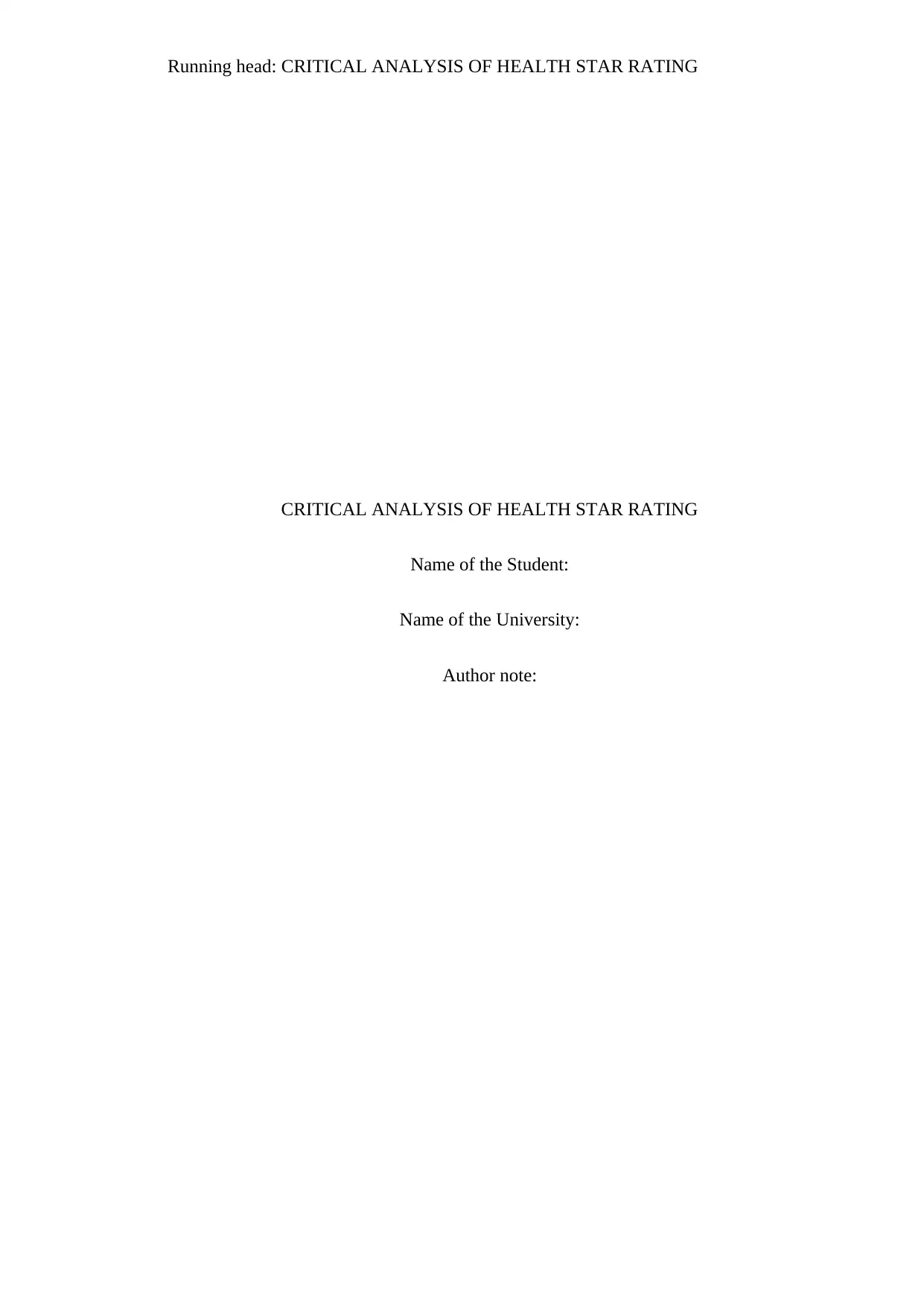
Running head: CRITICAL ANALYSIS OF HEALTH STAR RATING
CRITICAL ANALYSIS OF HEALTH STAR RATING
Name of the Student:
Name of the University:
Author note:
CRITICAL ANALYSIS OF HEALTH STAR RATING
Name of the Student:
Name of the University:
Author note:
Secure Best Marks with AI Grader
Need help grading? Try our AI Grader for instant feedback on your assignments.
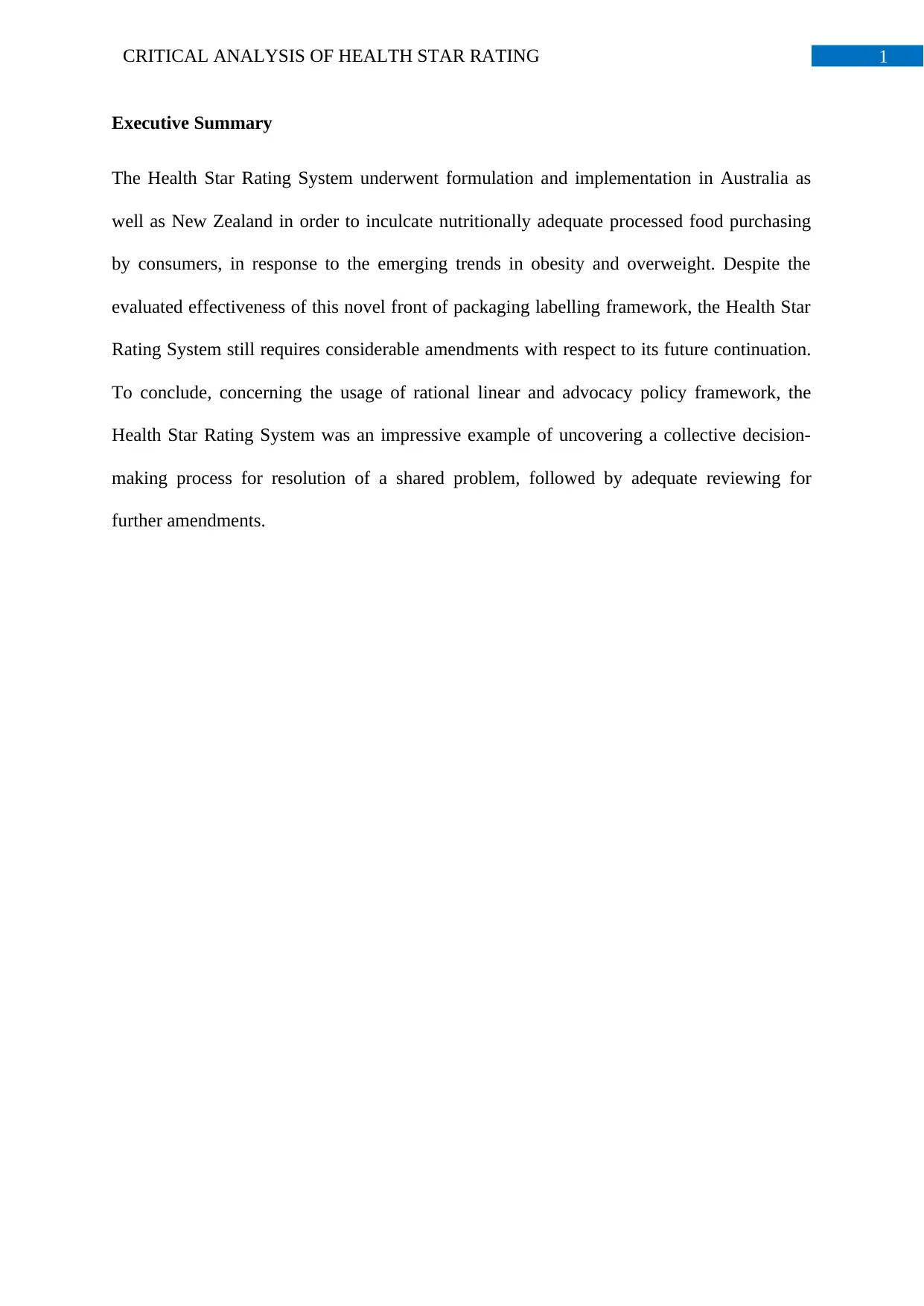
1CRITICAL ANALYSIS OF HEALTH STAR RATING
Executive Summary
The Health Star Rating System underwent formulation and implementation in Australia as
well as New Zealand in order to inculcate nutritionally adequate processed food purchasing
by consumers, in response to the emerging trends in obesity and overweight. Despite the
evaluated effectiveness of this novel front of packaging labelling framework, the Health Star
Rating System still requires considerable amendments with respect to its future continuation.
To conclude, concerning the usage of rational linear and advocacy policy framework, the
Health Star Rating System was an impressive example of uncovering a collective decision-
making process for resolution of a shared problem, followed by adequate reviewing for
further amendments.
Executive Summary
The Health Star Rating System underwent formulation and implementation in Australia as
well as New Zealand in order to inculcate nutritionally adequate processed food purchasing
by consumers, in response to the emerging trends in obesity and overweight. Despite the
evaluated effectiveness of this novel front of packaging labelling framework, the Health Star
Rating System still requires considerable amendments with respect to its future continuation.
To conclude, concerning the usage of rational linear and advocacy policy framework, the
Health Star Rating System was an impressive example of uncovering a collective decision-
making process for resolution of a shared problem, followed by adequate reviewing for
further amendments.
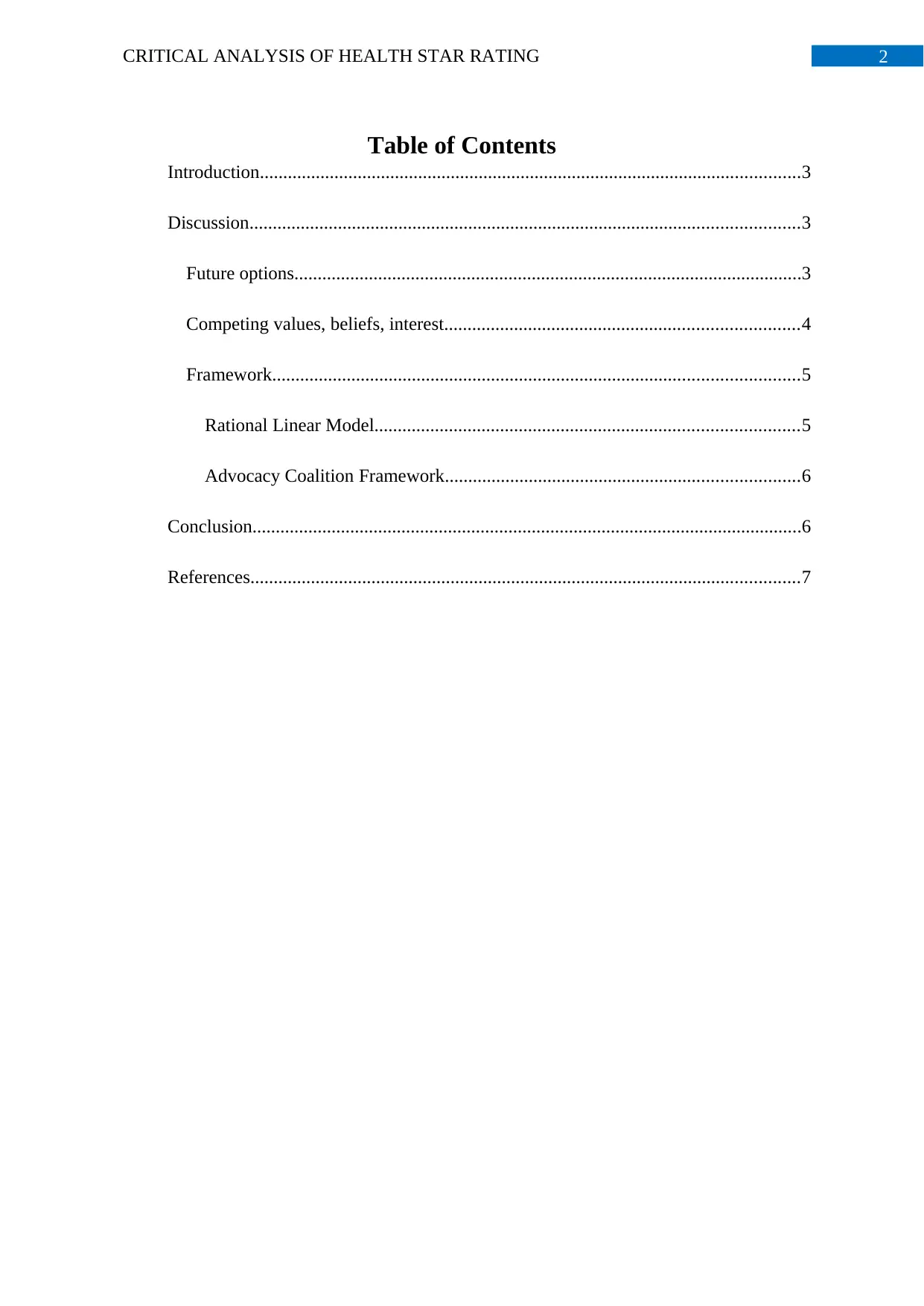
2CRITICAL ANALYSIS OF HEALTH STAR RATING
Table of Contents
Introduction....................................................................................................................3
Discussion......................................................................................................................3
Future options.............................................................................................................3
Competing values, beliefs, interest............................................................................4
Framework.................................................................................................................5
Rational Linear Model...........................................................................................5
Advocacy Coalition Framework............................................................................6
Conclusion......................................................................................................................6
References......................................................................................................................7
Table of Contents
Introduction....................................................................................................................3
Discussion......................................................................................................................3
Future options.............................................................................................................3
Competing values, beliefs, interest............................................................................4
Framework.................................................................................................................5
Rational Linear Model...........................................................................................5
Advocacy Coalition Framework............................................................................6
Conclusion......................................................................................................................6
References......................................................................................................................7
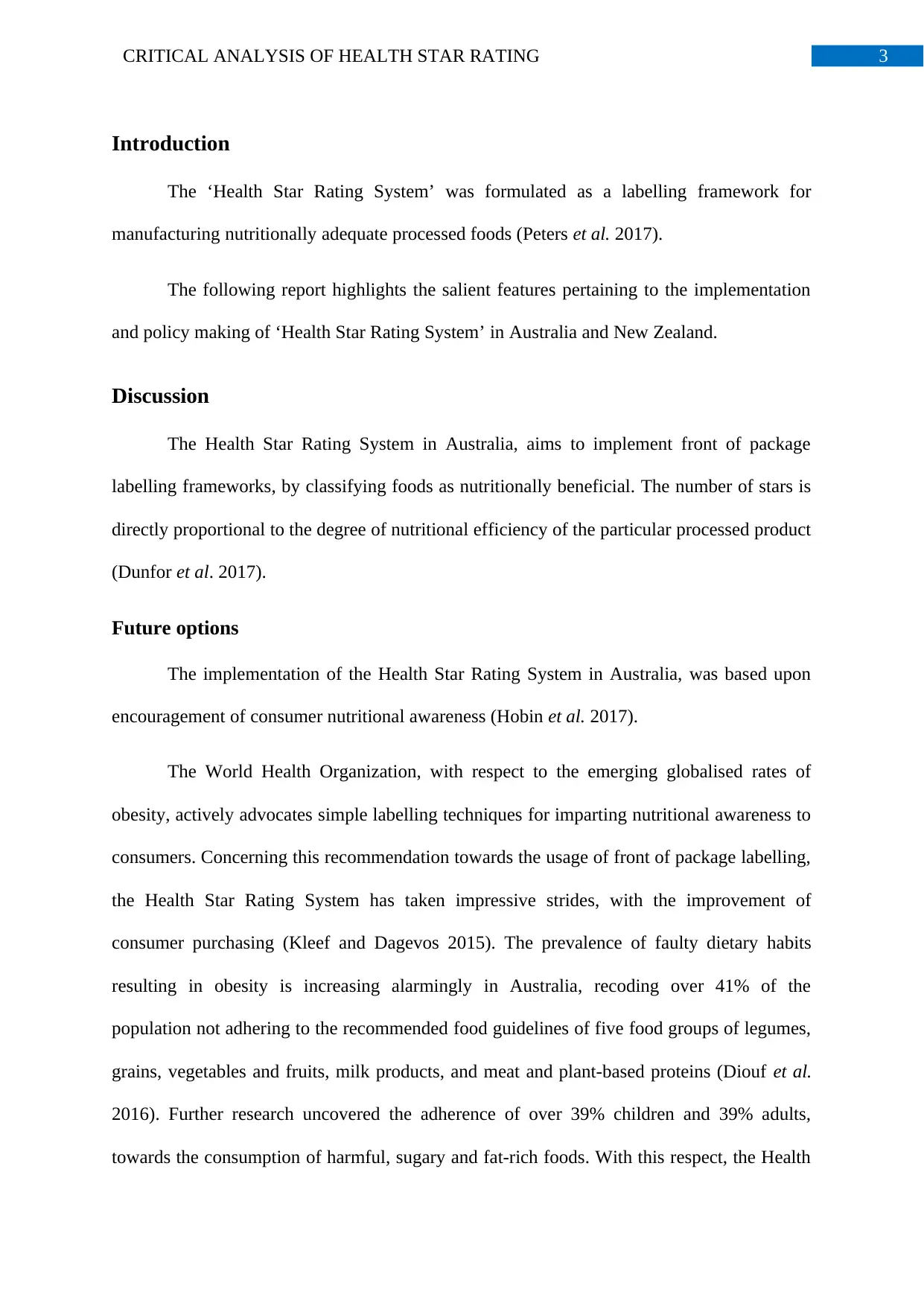
3CRITICAL ANALYSIS OF HEALTH STAR RATING
Introduction
The ‘Health Star Rating System’ was formulated as a labelling framework for
manufacturing nutritionally adequate processed foods (Peters et al. 2017).
The following report highlights the salient features pertaining to the implementation
and policy making of ‘Health Star Rating System’ in Australia and New Zealand.
Discussion
The Health Star Rating System in Australia, aims to implement front of package
labelling frameworks, by classifying foods as nutritionally beneficial. The number of stars is
directly proportional to the degree of nutritional efficiency of the particular processed product
(Dunfor et al. 2017).
Future options
The implementation of the Health Star Rating System in Australia, was based upon
encouragement of consumer nutritional awareness (Hobin et al. 2017).
The World Health Organization, with respect to the emerging globalised rates of
obesity, actively advocates simple labelling techniques for imparting nutritional awareness to
consumers. Concerning this recommendation towards the usage of front of package labelling,
the Health Star Rating System has taken impressive strides, with the improvement of
consumer purchasing (Kleef and Dagevos 2015). The prevalence of faulty dietary habits
resulting in obesity is increasing alarmingly in Australia, recoding over 41% of the
population not adhering to the recommended food guidelines of five food groups of legumes,
grains, vegetables and fruits, milk products, and meat and plant-based proteins (Diouf et al.
2016). Further research uncovered the adherence of over 39% children and 39% adults,
towards the consumption of harmful, sugary and fat-rich foods. With this respect, the Health
Introduction
The ‘Health Star Rating System’ was formulated as a labelling framework for
manufacturing nutritionally adequate processed foods (Peters et al. 2017).
The following report highlights the salient features pertaining to the implementation
and policy making of ‘Health Star Rating System’ in Australia and New Zealand.
Discussion
The Health Star Rating System in Australia, aims to implement front of package
labelling frameworks, by classifying foods as nutritionally beneficial. The number of stars is
directly proportional to the degree of nutritional efficiency of the particular processed product
(Dunfor et al. 2017).
Future options
The implementation of the Health Star Rating System in Australia, was based upon
encouragement of consumer nutritional awareness (Hobin et al. 2017).
The World Health Organization, with respect to the emerging globalised rates of
obesity, actively advocates simple labelling techniques for imparting nutritional awareness to
consumers. Concerning this recommendation towards the usage of front of package labelling,
the Health Star Rating System has taken impressive strides, with the improvement of
consumer purchasing (Kleef and Dagevos 2015). The prevalence of faulty dietary habits
resulting in obesity is increasing alarmingly in Australia, recoding over 41% of the
population not adhering to the recommended food guidelines of five food groups of legumes,
grains, vegetables and fruits, milk products, and meat and plant-based proteins (Diouf et al.
2016). Further research uncovered the adherence of over 39% children and 39% adults,
towards the consumption of harmful, sugary and fat-rich foods. With this respect, the Health
Secure Best Marks with AI Grader
Need help grading? Try our AI Grader for instant feedback on your assignments.
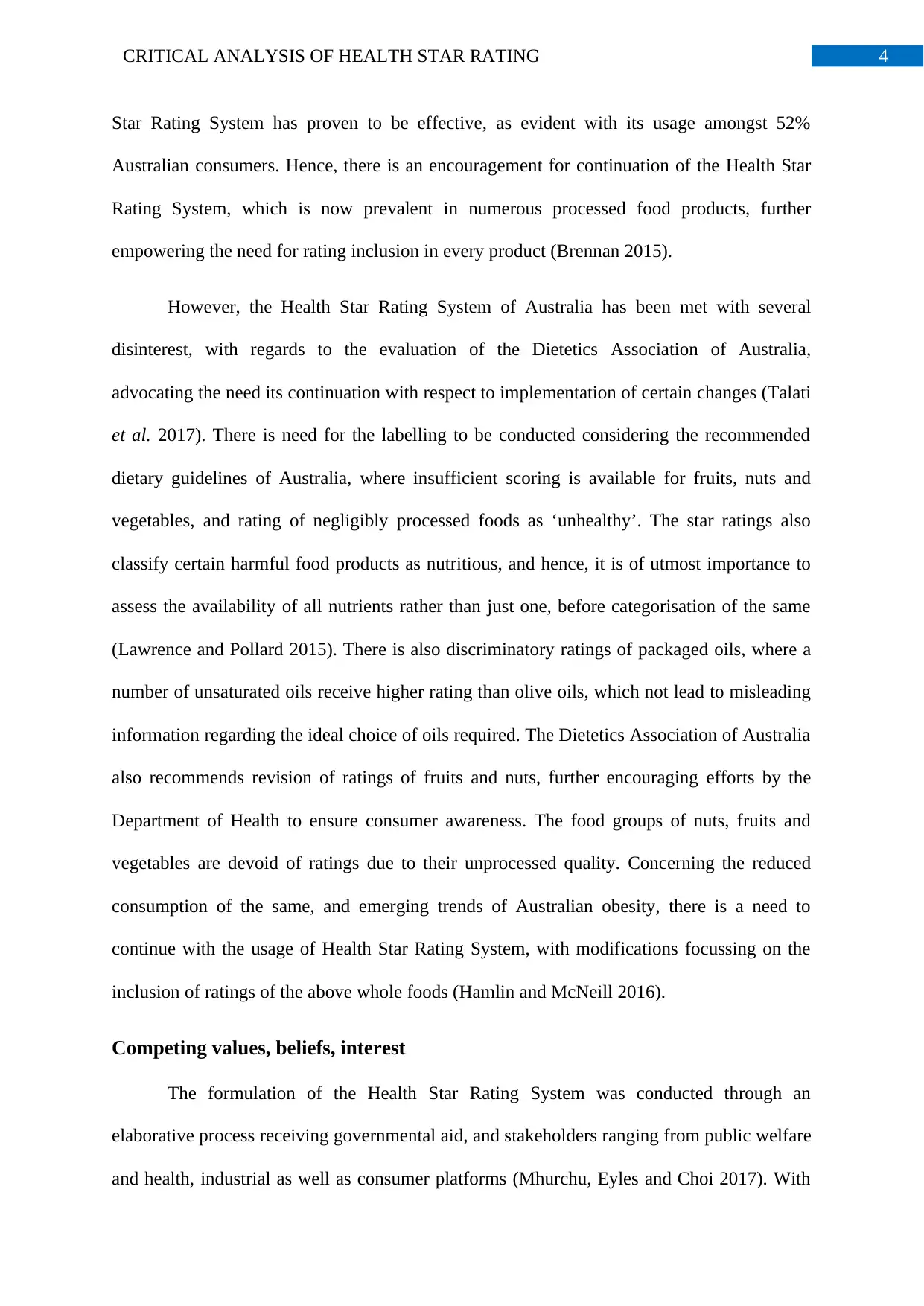
4CRITICAL ANALYSIS OF HEALTH STAR RATING
Star Rating System has proven to be effective, as evident with its usage amongst 52%
Australian consumers. Hence, there is an encouragement for continuation of the Health Star
Rating System, which is now prevalent in numerous processed food products, further
empowering the need for rating inclusion in every product (Brennan 2015).
However, the Health Star Rating System of Australia has been met with several
disinterest, with regards to the evaluation of the Dietetics Association of Australia,
advocating the need its continuation with respect to implementation of certain changes (Talati
et al. 2017). There is need for the labelling to be conducted considering the recommended
dietary guidelines of Australia, where insufficient scoring is available for fruits, nuts and
vegetables, and rating of negligibly processed foods as ‘unhealthy’. The star ratings also
classify certain harmful food products as nutritious, and hence, it is of utmost importance to
assess the availability of all nutrients rather than just one, before categorisation of the same
(Lawrence and Pollard 2015). There is also discriminatory ratings of packaged oils, where a
number of unsaturated oils receive higher rating than olive oils, which not lead to misleading
information regarding the ideal choice of oils required. The Dietetics Association of Australia
also recommends revision of ratings of fruits and nuts, further encouraging efforts by the
Department of Health to ensure consumer awareness. The food groups of nuts, fruits and
vegetables are devoid of ratings due to their unprocessed quality. Concerning the reduced
consumption of the same, and emerging trends of Australian obesity, there is a need to
continue with the usage of Health Star Rating System, with modifications focussing on the
inclusion of ratings of the above whole foods (Hamlin and McNeill 2016).
Competing values, beliefs, interest
The formulation of the Health Star Rating System was conducted through an
elaborative process receiving governmental aid, and stakeholders ranging from public welfare
and health, industrial as well as consumer platforms (Mhurchu, Eyles and Choi 2017). With
Star Rating System has proven to be effective, as evident with its usage amongst 52%
Australian consumers. Hence, there is an encouragement for continuation of the Health Star
Rating System, which is now prevalent in numerous processed food products, further
empowering the need for rating inclusion in every product (Brennan 2015).
However, the Health Star Rating System of Australia has been met with several
disinterest, with regards to the evaluation of the Dietetics Association of Australia,
advocating the need its continuation with respect to implementation of certain changes (Talati
et al. 2017). There is need for the labelling to be conducted considering the recommended
dietary guidelines of Australia, where insufficient scoring is available for fruits, nuts and
vegetables, and rating of negligibly processed foods as ‘unhealthy’. The star ratings also
classify certain harmful food products as nutritious, and hence, it is of utmost importance to
assess the availability of all nutrients rather than just one, before categorisation of the same
(Lawrence and Pollard 2015). There is also discriminatory ratings of packaged oils, where a
number of unsaturated oils receive higher rating than olive oils, which not lead to misleading
information regarding the ideal choice of oils required. The Dietetics Association of Australia
also recommends revision of ratings of fruits and nuts, further encouraging efforts by the
Department of Health to ensure consumer awareness. The food groups of nuts, fruits and
vegetables are devoid of ratings due to their unprocessed quality. Concerning the reduced
consumption of the same, and emerging trends of Australian obesity, there is a need to
continue with the usage of Health Star Rating System, with modifications focussing on the
inclusion of ratings of the above whole foods (Hamlin and McNeill 2016).
Competing values, beliefs, interest
The formulation of the Health Star Rating System was conducted through an
elaborative process receiving governmental aid, and stakeholders ranging from public welfare
and health, industrial as well as consumer platforms (Mhurchu, Eyles and Choi 2017). With

5CRITICAL ANALYSIS OF HEALTH STAR RATING
further consultation from the Department of Health and Ageing, the idea of incorporating
innovative labelling techniques were executed, through the convention of a project committee
involving the above mentioned policy stakeholders, during the year 2014, with the process
still undergoing 2 years of usage and 5 years of further review. Concerning its usage, the
labelling system has been overcome by considerable conflict, especially from the Australian
Food and Grocery Council, upon complaints of its financial unfeasibility and nutritional
incorrectness (Crino et al. 2017).
Further controversies from stakeholders against the Health Star Rating System, was
an absence of similarity to the ‘Daily Intake Guide’ during the process of providing star
ratings of the concerned food (Lawrence, Dickie and Woods 2018). While the stakeholders
pertaining to consumer health and public welfare advisory bodies conflicted to avoid the
coordinated presence of star ratings and daily intake guides, due to possibility of confusion
amongst buyers, the Health Star Rating Committee ultimately arrived at the conclusion that
its ratings could exist in coordination with the ‘Daily Intake Guide’ (Jones, Rådholm and
Neal 2018). Further, the ‘Obesity Policy Coalition’ also necessitates the need for the Health
Star Rating System, to include star classifications for sugar based products such as
sweeteners and syrups, with due respect to the evidence pertained by the World Health
Organization, in considering the excessive ingestion of sugary foods as key factors resulting
in obesity (Vandevijvere and Swinburn 2015).
Framework
The following paragraphs highlights the key factors pertaining to the policy
framework of the Health Star Rating System.
further consultation from the Department of Health and Ageing, the idea of incorporating
innovative labelling techniques were executed, through the convention of a project committee
involving the above mentioned policy stakeholders, during the year 2014, with the process
still undergoing 2 years of usage and 5 years of further review. Concerning its usage, the
labelling system has been overcome by considerable conflict, especially from the Australian
Food and Grocery Council, upon complaints of its financial unfeasibility and nutritional
incorrectness (Crino et al. 2017).
Further controversies from stakeholders against the Health Star Rating System, was
an absence of similarity to the ‘Daily Intake Guide’ during the process of providing star
ratings of the concerned food (Lawrence, Dickie and Woods 2018). While the stakeholders
pertaining to consumer health and public welfare advisory bodies conflicted to avoid the
coordinated presence of star ratings and daily intake guides, due to possibility of confusion
amongst buyers, the Health Star Rating Committee ultimately arrived at the conclusion that
its ratings could exist in coordination with the ‘Daily Intake Guide’ (Jones, Rådholm and
Neal 2018). Further, the ‘Obesity Policy Coalition’ also necessitates the need for the Health
Star Rating System, to include star classifications for sugar based products such as
sweeteners and syrups, with due respect to the evidence pertained by the World Health
Organization, in considering the excessive ingestion of sugary foods as key factors resulting
in obesity (Vandevijvere and Swinburn 2015).
Framework
The following paragraphs highlights the key factors pertaining to the policy
framework of the Health Star Rating System.
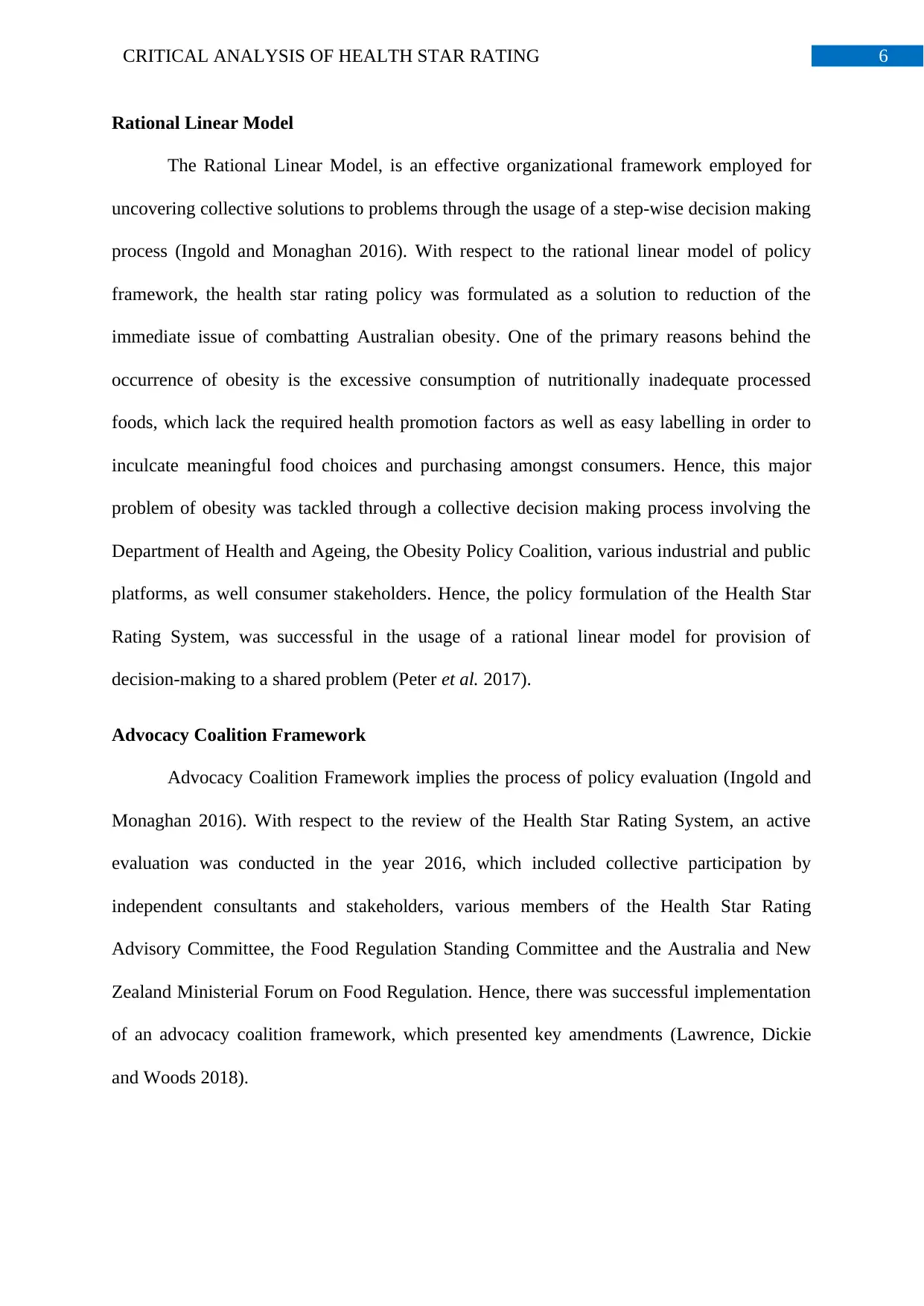
6CRITICAL ANALYSIS OF HEALTH STAR RATING
Rational Linear Model
The Rational Linear Model, is an effective organizational framework employed for
uncovering collective solutions to problems through the usage of a step-wise decision making
process (Ingold and Monaghan 2016). With respect to the rational linear model of policy
framework, the health star rating policy was formulated as a solution to reduction of the
immediate issue of combatting Australian obesity. One of the primary reasons behind the
occurrence of obesity is the excessive consumption of nutritionally inadequate processed
foods, which lack the required health promotion factors as well as easy labelling in order to
inculcate meaningful food choices and purchasing amongst consumers. Hence, this major
problem of obesity was tackled through a collective decision making process involving the
Department of Health and Ageing, the Obesity Policy Coalition, various industrial and public
platforms, as well consumer stakeholders. Hence, the policy formulation of the Health Star
Rating System, was successful in the usage of a rational linear model for provision of
decision-making to a shared problem (Peter et al. 2017).
Advocacy Coalition Framework
Advocacy Coalition Framework implies the process of policy evaluation (Ingold and
Monaghan 2016). With respect to the review of the Health Star Rating System, an active
evaluation was conducted in the year 2016, which included collective participation by
independent consultants and stakeholders, various members of the Health Star Rating
Advisory Committee, the Food Regulation Standing Committee and the Australia and New
Zealand Ministerial Forum on Food Regulation. Hence, there was successful implementation
of an advocacy coalition framework, which presented key amendments (Lawrence, Dickie
and Woods 2018).
Rational Linear Model
The Rational Linear Model, is an effective organizational framework employed for
uncovering collective solutions to problems through the usage of a step-wise decision making
process (Ingold and Monaghan 2016). With respect to the rational linear model of policy
framework, the health star rating policy was formulated as a solution to reduction of the
immediate issue of combatting Australian obesity. One of the primary reasons behind the
occurrence of obesity is the excessive consumption of nutritionally inadequate processed
foods, which lack the required health promotion factors as well as easy labelling in order to
inculcate meaningful food choices and purchasing amongst consumers. Hence, this major
problem of obesity was tackled through a collective decision making process involving the
Department of Health and Ageing, the Obesity Policy Coalition, various industrial and public
platforms, as well consumer stakeholders. Hence, the policy formulation of the Health Star
Rating System, was successful in the usage of a rational linear model for provision of
decision-making to a shared problem (Peter et al. 2017).
Advocacy Coalition Framework
Advocacy Coalition Framework implies the process of policy evaluation (Ingold and
Monaghan 2016). With respect to the review of the Health Star Rating System, an active
evaluation was conducted in the year 2016, which included collective participation by
independent consultants and stakeholders, various members of the Health Star Rating
Advisory Committee, the Food Regulation Standing Committee and the Australia and New
Zealand Ministerial Forum on Food Regulation. Hence, there was successful implementation
of an advocacy coalition framework, which presented key amendments (Lawrence, Dickie
and Woods 2018).
Paraphrase This Document
Need a fresh take? Get an instant paraphrase of this document with our AI Paraphraser
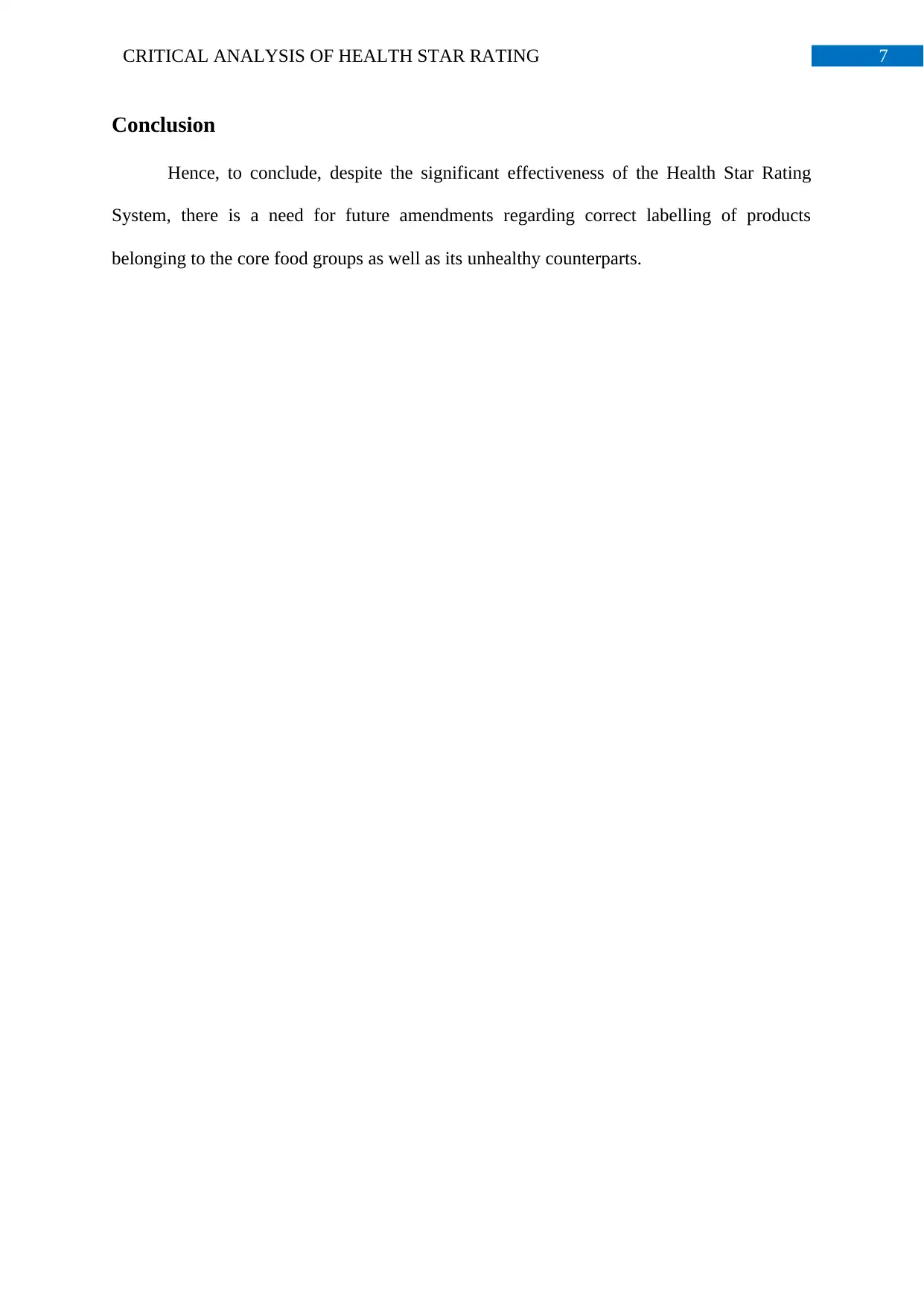
7CRITICAL ANALYSIS OF HEALTH STAR RATING
Conclusion
Hence, to conclude, despite the significant effectiveness of the Health Star Rating
System, there is a need for future amendments regarding correct labelling of products
belonging to the core food groups as well as its unhealthy counterparts.
Conclusion
Hence, to conclude, despite the significant effectiveness of the Health Star Rating
System, there is a need for future amendments regarding correct labelling of products
belonging to the core food groups as well as its unhealthy counterparts.

8CRITICAL ANALYSIS OF HEALTH STAR RATING
References
Brennan, M., 2015. Is the Health Star Rating System a Thin Response to a Fat Problem: An
Examination of the Constitutionality of a Mandatory Front Package Labelling System. U.
Notre Dame Austl. L. Rev., 17, p.86.
Crino, M., Herrera, A.M.M., Ananthapavan, J., Wu, J.H., Neal, B., Lee, Y.Y., Zheng, M.,
Lal, A. and Sacks, G., 2017. Modelled cost-effectiveness of a package size cap and a
kilojoule reduction intervention to reduce energy intake from sugar-sweetened beverages in
Australia. Nutrients, 9(9), p.983.
Diouf, I., Magliano, D.J., Carrington, M.J., Stewart, S. and Shaw, J.E., 2016. Prevalence,
incidence, risk factors and treatment of atrial fibrillation in Australia: The Australian
Diabetes, Obesity and Lifestyle (AusDiab) longitudinal, population cohort study.
International journal of cardiology, 205, pp.127-132.
Dunford, E.K., Wu, J.H., Wellard-Cole, L., Watson, W., Crino, M., Petersen, K. and Neal, B.,
2017. A comparison of the Health Star Rating system when used for restaurant fast foods and
packaged foods. Appetite, 117, pp.1-8.
Hamlin, R. and McNeill, L., 2016. Does the Australasian “health star rating” front of pack
nutritional label system work?. Nutrients, 8(6), p.327.
Hobin, E., Bollinger, B., Sacco, J., Liebman, E., Vanderlee, L., Zuo, F., Rosella, L., L'abbe,
M., Manson, H. and Hammond, D., 2017. Consumers’ Response to an On‐Shelf Nutrition
Labelling System in Supermarkets: Evidence to Inform Policy and Practice. The Milbank
Quarterly, 95(3), pp.494-534.
Ingold, J. and Monaghan, M., 2016. Evidence translation: an exploration of policy makers'
use of evidence. Policy & Politics, 44(2), pp.171-190.
References
Brennan, M., 2015. Is the Health Star Rating System a Thin Response to a Fat Problem: An
Examination of the Constitutionality of a Mandatory Front Package Labelling System. U.
Notre Dame Austl. L. Rev., 17, p.86.
Crino, M., Herrera, A.M.M., Ananthapavan, J., Wu, J.H., Neal, B., Lee, Y.Y., Zheng, M.,
Lal, A. and Sacks, G., 2017. Modelled cost-effectiveness of a package size cap and a
kilojoule reduction intervention to reduce energy intake from sugar-sweetened beverages in
Australia. Nutrients, 9(9), p.983.
Diouf, I., Magliano, D.J., Carrington, M.J., Stewart, S. and Shaw, J.E., 2016. Prevalence,
incidence, risk factors and treatment of atrial fibrillation in Australia: The Australian
Diabetes, Obesity and Lifestyle (AusDiab) longitudinal, population cohort study.
International journal of cardiology, 205, pp.127-132.
Dunford, E.K., Wu, J.H., Wellard-Cole, L., Watson, W., Crino, M., Petersen, K. and Neal, B.,
2017. A comparison of the Health Star Rating system when used for restaurant fast foods and
packaged foods. Appetite, 117, pp.1-8.
Hamlin, R. and McNeill, L., 2016. Does the Australasian “health star rating” front of pack
nutritional label system work?. Nutrients, 8(6), p.327.
Hobin, E., Bollinger, B., Sacco, J., Liebman, E., Vanderlee, L., Zuo, F., Rosella, L., L'abbe,
M., Manson, H. and Hammond, D., 2017. Consumers’ Response to an On‐Shelf Nutrition
Labelling System in Supermarkets: Evidence to Inform Policy and Practice. The Milbank
Quarterly, 95(3), pp.494-534.
Ingold, J. and Monaghan, M., 2016. Evidence translation: an exploration of policy makers'
use of evidence. Policy & Politics, 44(2), pp.171-190.

9CRITICAL ANALYSIS OF HEALTH STAR RATING
Jones, A., Rådholm, K. and Neal, B., 2018. Defining ‘Unhealthy’: A Systematic Analysis of
Alignment between the Australian Dietary Guidelines and the Health Star Rating System.
Nutrients, 10(4), p.501.
Kleef, E.V. and Dagevos, H., 2015. The growing role of front-of-pack nutrition profile
labeling: a consumer perspective on key issues and controversies. Critical reviews in food
science and nutrition, 55(3), pp.291-303.
Lawrence, M. and Pollard, C., 2015. A year on, Australia's health star food-rating system is
showing cracks. Journal of the Home Economics Institute of Australia, 22(2), p.34.
Lawrence, M.A., Dickie, S. and Woods, J.L., 2018. Do nutrient-based front-of-pack labelling
schemes support or undermine food-based dietary guideline recommendations? Lessons from
the Australian Health Star Rating System. Nutrients, 10(1), p.32.
Mhurchu, C.N., Eyles, H. and Choi, Y.H., 2017. Effects of a voluntary front-of-pack nutrition
labelling system on packaged food reformulation: The health star rating system in New
Zealand. Nutrients, 9(8), p.918.
Peters, S., Dunford, E., Jones, A., Ni Mhurchu, C., Crino, M., Taylor, F., Woodward, M. and
Neal, B., 2017. Incorporating added sugar improves the performance of the health star rating
front-of-pack labelling system in Australia. Nutrients, 9(7), p.701.
Talati, Z., Pettigrew, S., Ball, K., Hughes, C., Kelly, B., Neal, B. and Dixon, H., 2017. The
relative ability of different front-of-pack labels to assist consumers discriminate between
healthy, moderately healthy, and unhealthy foods. Food quality and preference, 59, pp.109-
113.
Jones, A., Rådholm, K. and Neal, B., 2018. Defining ‘Unhealthy’: A Systematic Analysis of
Alignment between the Australian Dietary Guidelines and the Health Star Rating System.
Nutrients, 10(4), p.501.
Kleef, E.V. and Dagevos, H., 2015. The growing role of front-of-pack nutrition profile
labeling: a consumer perspective on key issues and controversies. Critical reviews in food
science and nutrition, 55(3), pp.291-303.
Lawrence, M. and Pollard, C., 2015. A year on, Australia's health star food-rating system is
showing cracks. Journal of the Home Economics Institute of Australia, 22(2), p.34.
Lawrence, M.A., Dickie, S. and Woods, J.L., 2018. Do nutrient-based front-of-pack labelling
schemes support or undermine food-based dietary guideline recommendations? Lessons from
the Australian Health Star Rating System. Nutrients, 10(1), p.32.
Mhurchu, C.N., Eyles, H. and Choi, Y.H., 2017. Effects of a voluntary front-of-pack nutrition
labelling system on packaged food reformulation: The health star rating system in New
Zealand. Nutrients, 9(8), p.918.
Peters, S., Dunford, E., Jones, A., Ni Mhurchu, C., Crino, M., Taylor, F., Woodward, M. and
Neal, B., 2017. Incorporating added sugar improves the performance of the health star rating
front-of-pack labelling system in Australia. Nutrients, 9(7), p.701.
Talati, Z., Pettigrew, S., Ball, K., Hughes, C., Kelly, B., Neal, B. and Dixon, H., 2017. The
relative ability of different front-of-pack labels to assist consumers discriminate between
healthy, moderately healthy, and unhealthy foods. Food quality and preference, 59, pp.109-
113.
Secure Best Marks with AI Grader
Need help grading? Try our AI Grader for instant feedback on your assignments.
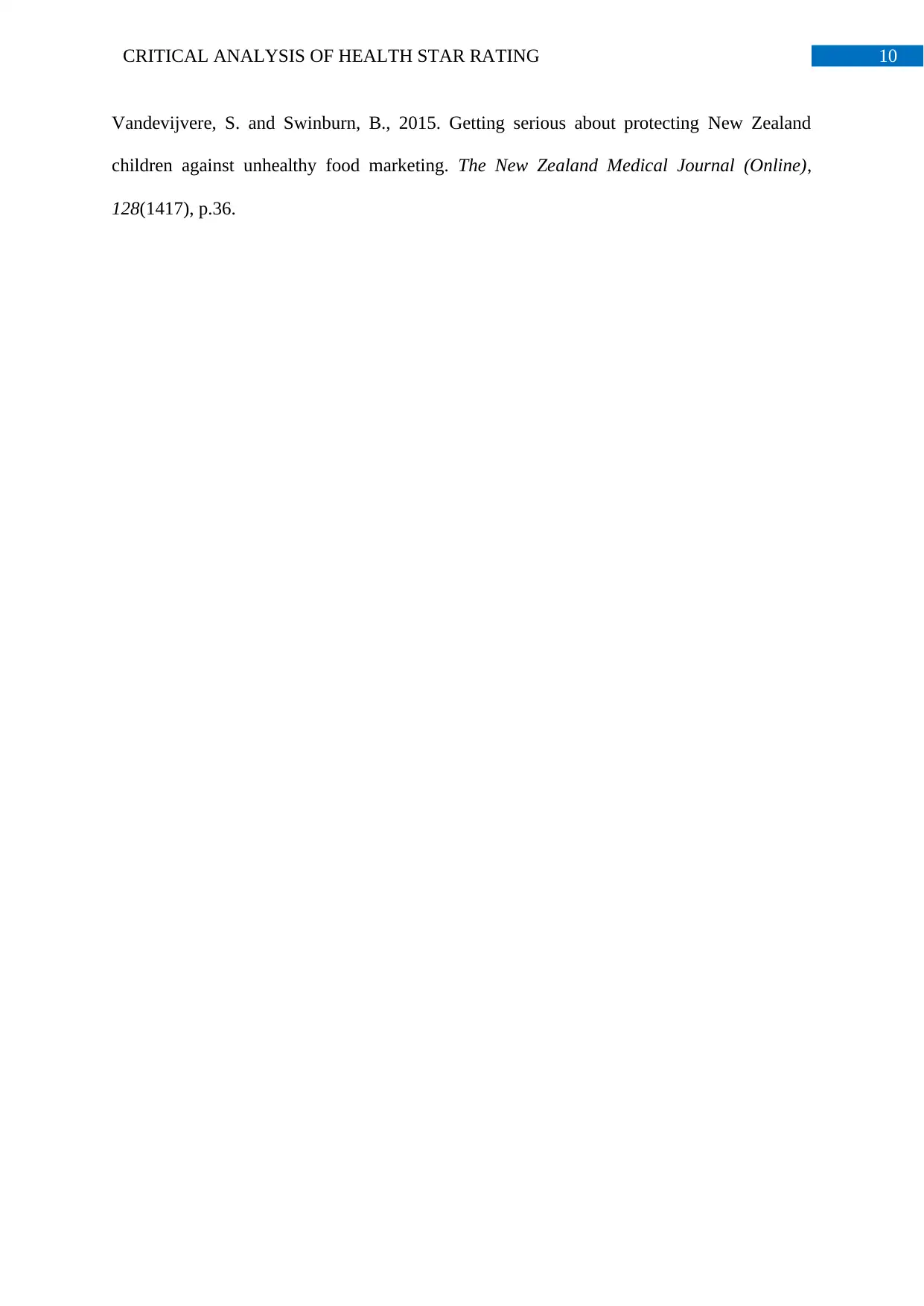
10CRITICAL ANALYSIS OF HEALTH STAR RATING
Vandevijvere, S. and Swinburn, B., 2015. Getting serious about protecting New Zealand
children against unhealthy food marketing. The New Zealand Medical Journal (Online),
128(1417), p.36.
Vandevijvere, S. and Swinburn, B., 2015. Getting serious about protecting New Zealand
children against unhealthy food marketing. The New Zealand Medical Journal (Online),
128(1417), p.36.
1 out of 11
Related Documents
Your All-in-One AI-Powered Toolkit for Academic Success.
+13062052269
info@desklib.com
Available 24*7 on WhatsApp / Email
![[object Object]](/_next/static/media/star-bottom.7253800d.svg)
Unlock your academic potential
© 2024 | Zucol Services PVT LTD | All rights reserved.



